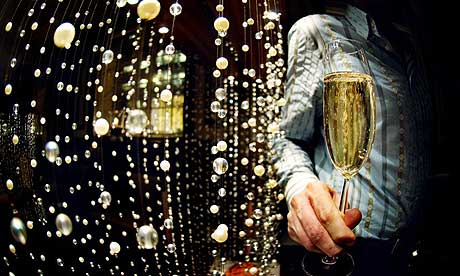
It's the sound that signifies celebrations and rites of passage: the popping of champagne corks means that something momentous has happened. No doubt there will be a lot of corks popping tonight. OK, maybe there'll be fewer this year than previously, but that's all the more reason to choose your bottle wisely - and what could be wiser than choosing champagne that makes you thin!
All right, that might be slightly over-hyped. Try as they might, it's unlikely that scientists, vintners or alchemists will ever perfect a drink that is entirely guilt-free (apart from water, but that exists already). But for those that care about their calorie consumption - or even just prefer to cut down the amount of sugar they unwittingly consume - there's a growing market in 'low dosage' and 'zero dosage' champagne.
Low dosage is basically a fancy name for having less sugar in your bubbles. Didn't know there was sugar in them at all? There is - and how much makes a great difference not only to the taste, but to the calorie count as well.
Champagne is made by a long, complex process: growing, picking and pressing the grapes; fermenting once then blending different varieties (usually chardonnay, pinot noir and pinot meunier); fermenting again; leaving in cold dark cellars for years and years with a mixture of yeast in the bottle that helps the bubbles develop.
In the very last stage, the bottle is opened, the yeast mixture removed, and, traditionally, an injection of sugar and sometimes alcohol (brandy, or a shot of champagne of another vintage - the recipes are secret and differ from house to house) is added before the cork is forced back in, and the wire cage added to keep the bugger from unpopping itself.
That injection is called the dosage. Historically, champagne was much sweeter - much more like demi-sec, which contains up to 50g of sugar a litre. The average brut, in contrast, contains less than 15g. Now, increasingly, 'ultra-brut' wines are available, with less than 6g of sugar a litre added at the end. Much ultra-brut champagne is 'zero dosage', which means that no sugar at all is added in the final stage, and the only sweetness in the wine comes from the residual fruit sugars of the grape.
Does it make any difference? Roughly speaking, a normal glass of brut champagne contains about 90-100 calories, while a glass of zero dosage contains 59-65. So unless you drink an awful lot of champagne, it's difficult to imagine that sipping zero dosage will alleviate any weight worries. But there are other differences, too.
Many people will appreciate the fact that their zero-dosage wine is additive free. Organic wine is already a growing movement in the Champagne region. At LeClerc Briant - a small-ish champagne house in the village of Epernay - they are even following biodynamic methods. Walking among hundreds of thousands of bottles in the chalk cellars, 100ft down in the earth, I got a sense of why champagne is considered so special. You wouldn't even know they were there, driving over the hillsides above, but there are whole silent cathedrals filled with bubbles below.
Now champagne houses are starting to lose the sugar as well as the pesticides. Ayala, part of the Bollinger family, is one that caters to the growing demand for low-dosage champagne, as does Laurent-Perrier with its low-cal ultra-brut. The taste is startlingly different to other champagnes you might have tried. It may taste slightly odd to those, like me, who have always drunk whatever champagne is handed to them before a toast. It's less sweet, obviously, and flavours of the grapes seem to come through more clearly: blends containing more chardonnay taste sharp, light and citrussy; ones based on pinot noir appear rounder and more fruity.
For a nation that is increasingly interested in what we put in our mouths, this seems like just the kind of thing we might go for. And so it should be: according to the cellar masters at Laurent-Perrier - who have been blending their brut for two hundred years, so hopefully should know a bit about it - the British, still the largest export market for wines from the Champagne region, were the ones who pushed the move toward drier fizz in the first place. While the rest of Europe favoured a bottle half-full of sugar, the British fondness for savouries created the market for brut and ultra-brut. We've always had good taste, it would seem.
I used to assume that all champagne was essentially the same, and I didn't have a clue how it was made. Presumably it involved some wine, some heavy bottles and some kind of giant Soda Stream machine. Well, it turns out I was wrong on both counts.
Now all I have to do is change those silly fixed ideas about only drinking it at weddings and new year. As Lily Bollinger famously said of champagne: "I drink it when I'm happy and when I'm sad. Sometimes I drink it when I'm alone. When I have company I consider it obligatory. I trifle with it if I'm not hungry and I drink it when I am. Otherwise I never touch it, unless I'm thirsty."
But then, let's face it, if you own the Bollinger house, you probably get it all free. So she would say that.

